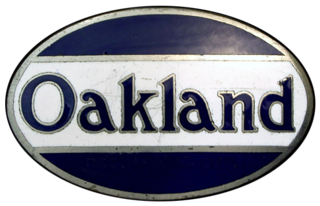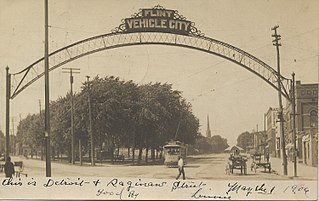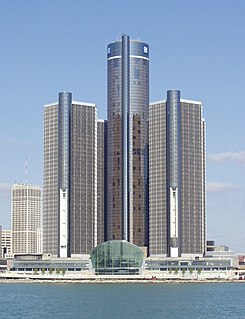
McLaughlin Motor Car Company Limited was a Canadian manufacturer of automobiles headquartered in Oshawa, Ontario. Founded by Robert McLaughlin, it once was the largest carriage manufacturing factory in the British Empire.

Charles Williams Nash was an American automobile entrepreneur who served as an executive in the automotive industry. He played a major role in building up General Motors as its 5th President. In 1916, he bought Thomas B. Jeffery Company, makers of the popular Rambler automobile, renamed it Nash Motors, and played an independent role in an automobile industry increasingly dominated by the Big Three: General Motors, Ford, and Chrysler. His profits came from focusing on one well-designed car in the upper-medium price range. He bought several distressed companies in Wisconsin, merging them and installing advanced managerial accounting procedures while cutting costs and focusing on long-term growth. He retired as president in 1932, but remained chairman of the board. His major acquisition was the merger in 1937 with the Kelvinator Company, which made refrigerators. During World War II, Nash-Kelvinator greatly expanded to manufacture aircraft engines and parts.

Louis-Joseph Chevrolet was a Swiss-American race car driver, mechanic and entrepreneur who co-founded the Chevrolet Motor Car Company in 1911.

William Crapo Durant was a leading pioneer of the United States automobile industry and co-founder of General Motors and Chevrolet. He created a system in which a company held multiple marques – each seemingly independent, with different automobile lines – bound under a unified corporate holding company. Durant, along with Frederic L. Smith, co-founded General Motors, as well as Chevrolet with Louis Chevrolet. He also founded Frigidaire.

Durant Motors Inc. was established in 1921 by former General Motors CEO William "Billy" Durant following his termination by the GM board of directors and the New York bankers who financed GM.

The Dort Motor Car Company of Flint, Michigan, built automobiles from 1915 to 1924.

Mason Motors, founded by A. C. Mason in cooperation with William C. Durant, was a U.S. truck manufacturer based in Flint, Michigan. As a subsidiary of Durant Motors, Mason Truck built Road King Speed Trucks in the early 1920s. Mason Motors also built automobile engines in 1911, who first led Buick's engine works in Flint. That company was absorbed by Chevrolet in 1915, but remained under the Chevrolet umbrella until January 1, 1918, when it became known as the Motor and Axle Division of Chevrolet.

The Oakland Motor Car Company of Pontiac, Michigan, was an American automobile manufacturer and division of General Motors. Purchased by General Motors in 1909, the company continued to produce modestly priced automobiles until 1931 when the brand was dropped in favor of the division's Pontiac make.

The Stutz Motor Car Company, was an American producer of high-end sports and luxury cars based in Indianapolis, Indiana. Production began in 1911 and ended in 1935.

Lansing Car Assembly was a General Motors automobile factory in Lansing, Michigan. It contained two elements, a 1901 automobile plant in downtown Lansing, and the 1920 Durant Motors factory on Lansing's Far Westside.

Wilmington Assembly was a General Motors automobile factory in Wilmington, Delaware. The 3,200,000-square-foot (300,000 m2) factory opened in 1947, and produced cars for GM's Chevrolet, Pontiac, Saturn, Opel, Buick and Daewoo brands during its operation. GM closed the plant on July 28, 2009.

Flint, Michigan is a city which previously relied on its automotive industry, and still does to an extent. Over the past several decades, General Motors plants in Genesee County have experienced re-namings, management shifts, openings, closures, reopenings, and spinoffs.

The history of General Motors (GM), one of the world's largest car and truck manufacturers, dates back more than a century and involves a vast scope of industrial activity around the world, mostly focused on motorized transportation and the engineering and manufacturing that make it possible. Founded in 1908 as a holding company in Flint, Michigan, as of 2012 it employed approximately 209,000 people around the world. With global headquarters at the Renaissance Center in Detroit, Michigan, United States, General Motors manufactures cars and trucks in 35 countries. In 2008, 8.35 million GM cars and trucks were sold globally under various brands. Current auto brands are Buick, Cadillac, Chevrolet, GMC, and Wuling. Former GM automotive brands include La Salle, McLaughlin, Oakland, Oldsmobile, Opel, Pontiac, Hummer, Saab, Saturn, Vauxhall, Daewoo and Holden.
The Little were two automobiles built in Flint, Michigan, from 1912 – 15 and the company, Little Motor Car Company, founded by William H. Little and William C. Durant that built them. It was incorporated into the current Chevrolet Motor Company.

Scripps-Booth was a United States automobile marque based in Detroit, Michigan. Established by James Scripps Booth in 1913, Scripps-Booth Company produced motor vehicles and was later acquired by General Motors, becoming a division of it, until the brand was discontinued in 1923.
Pontiac Assembly was one of four General Motors assembly plants in Pontiac, Michigan located along Baldwin Avenue. It served as the home factory for GM's Pontiac Motor Division since it was built in 1927. It was across the street from the currently operational Pontiac Metal Center, which was the original location for the Oakland Motor Car Company, which Pontiac evolved out of. It was also sometimes identified as being located in the city of Bloomfield, Michigan.

Durant-Dort Carriage Company was a manufacturer of horse-drawn vehicles in Flint, Michigan. Founded in 1886, by 1900 it was the largest carriage manufacturer in the country.
The W.F. Stewart Company was an American carriage body and automotive body manufacturer founded in 1881 by William Francis Stewart and based in Flint, Michigan. The company specialized in the design and manufacture of wooden carriage bodies for horse-drawn transport and later automotive bodies. The company also briefly produced light aircraft, but went out of business in the Great Depression.
Flint Wagon Works of Flint, Michigan, manufactured wagons from the early 1880s. One of the world's most successful horse-drawn vehicle makers they formed with their Flint neighbours a core of the American automobile industry. In 1905 Flint was promoting itself as Flint the Vehicle City. The former site is now located in the neighborhood of Flint as "Carriagetown".
Saginaw Metal Casting Operations is an automobile engine foundry plant in Saginaw, Michigan. Opened under GM management in 1919, the factory produces engine blocks and cylinder heads for General Motors vehicles. The factory currently occupies 1.9 million square feet on 490 acres. The location was originally the Marquette Motor Company until acquired by William Durant in 1909 when the car was discontinued in 1911. During World War I, it was used to manufacture mortar shells for the US Ordnance Corps, then was repurposed for engine block casting when operations at Northway Motor and Manufacturing Division ended in 1925. Historically in September 1927 it was known as the Chevrolet Grey Iron Foundry. In the past when it was called GM-Saginaw Product Company (SPC) a cloverleaf casting symbol mark was cast onto the iron component.

















